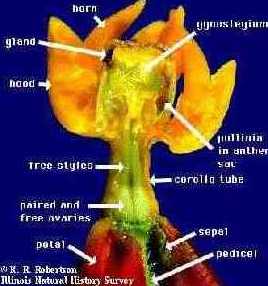
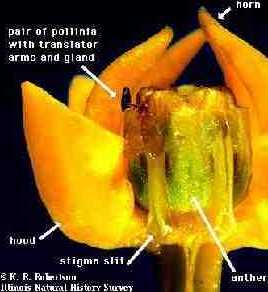
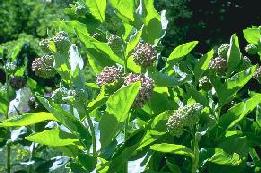 Common Milkweed (Asclepias syriaca)
is a fairly weedy plant found along roadsides
and in abandoned fields, growing to 4-6 feet tall. It has large (up to 10
inches), oval leaves with a prominent central vein and minute hairs that
give them a fuzzy feel. True to its name, it exudes a milky sap when broken.
The Common Milkweed has a strong root stock that grows
horizontally to pop up clones nearby and may form a colony.
Common Milkweed (Asclepias syriaca)
is a fairly weedy plant found along roadsides
and in abandoned fields, growing to 4-6 feet tall. It has large (up to 10
inches), oval leaves with a prominent central vein and minute hairs that
give them a fuzzy feel. True to its name, it exudes a milky sap when broken.
The Common Milkweed has a strong root stock that grows
horizontally to pop up clones nearby and may form a colony.
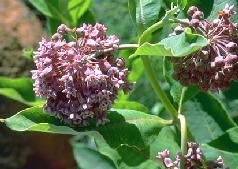
Like all milkweeds, its flowers bloom in June-July, and form a domed, somewhat drooping cluster of tiny, fragrant florets in shades of dusty rose, lavender, and dull brownish purple.
Each flower is 5-parted; the closeups below are of the curassavica
species (Bloodflower), though all Asclepias have the same structure.
 | Note the curious structure of pollinia with anthers (pollen-bearing organ) in sacs. An insect alighting on the flower often gets its legs trapped in the slits, and in struggling to free the legs, pull up the pollinia which become attached. When the hapless insect visits the next milkweed flower, it does the dance again, this time rubbing the pollinia off in the stigmatic slit to complete the pollinating cycle. Sometimes an insect fails to extricate its legs from the treacherous slits, and dies on the flower, but it's a beautiful way to die. |  |
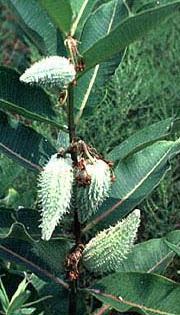 |
After flowering, a few warty seedpods develop from the withered flowers.
When ripe, the seedpods open to reveal brown, oval seeds attached to
silken down that float in the air like parachutes. Speaking pf parachutes,
the down was used to stuff life jackets for fighter pilots in World War II,
and birds like the Goldfinch use them to line their nests.
Milkweeds often play host to a bewildering variety of insects, from aphids (and their guardian ants), thrips, mites, leaf hoppers and spiders to milkweed beetles and milkweed bugs, not to mention pollinating bees. Of course, the Monarch Butterfly uses milkweed plants as host in the caterpillar stage, and eggs are laid on milkweeds. Sometimes you need to brush aside this busy menagerie to find the Monarch egg. Compiled by Peter for a nice tutor. | 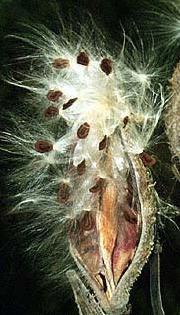 |